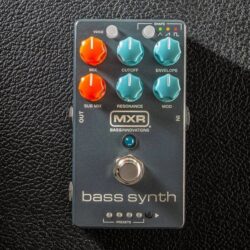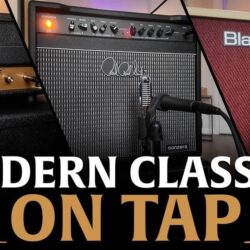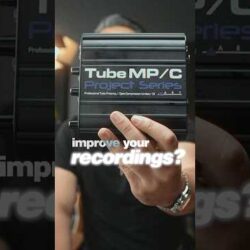
MXR Bass Synth Review
Synth-bass pedals have been around for a long time. They’ve come in a wide variety of flavors and achieved various degrees of success as far as tones and designs go. But, in my experience, they are a class of pedals that are tough to get right. Tracking and latency are always challenges. And they don’t always do a great job of approximating vintage synth-bass patches from classic recordings—specializing in sounds better suited for a sci-fi movie or avant/experimental projects than a Stevie Wonder or Michael Jackson context. MXR’s new Bass Synth, however, delivers where so many other bass synths fall short.Source MaterialIn developing the Bass Synth, MXR called on Ian Martin Allison for an artist’s perspective. Allison is a Minneapolis-based bass player with a prominent session resume, a regular on the very popular Scott’s Bass Lessons, and maintains a steady gig with singer-songwriter Eric Hutchinson. He also maintains his own strong online following by creating and sharing synth-bass-style tones made with traditional pedal combinations and his programmable multi-effects unit. Allison’s faithful reproductions of classic synth sounds created with electric bass made him the ideal sounding board for the MXR team.Can’t Judge a Book by Looking at the CoverAt a glance, the MXR Bass Synth looks pretty conventional. There are just six rotary controls and a few buttons. But looks, in this case, are deceiving. The MXR is feature-packed, and I couldn’t possibly cover all of them here. But the in-depth, 30-minute video instruction manual Jim Dunlop put up on YouTube hints at the expansiveness of its potential.For the convenience-minded player—or synth beginner—the heart, soul, and saving grace of this pedal might be the presets. Many bass players have limited experience with the process of real creative synthesis via waveforms and filters, and MXR’s factory presets help fast-track the leap to bass-synth sound design. There are many useful departure points and they make the pedal instantly usable. Allison had a hand in developing the presets, and most are easy to incorporate into your playing style. They include sounds inspired by Michael Jackson’s “Thriller,” Stevie Wonder’s TONTO synth, the Minimoog sound on Funkadelic’s “Flashlight,” as well as modern patches inspired by specific songs and artists as diverse as Björk, Nine Inch Nails, and Deadmau5—and that’s a short list of what’s here. There are user-programmable presets, too, of course, and expression-pedal compatibility enables filter sweeping and other effects. Like an Old, Funky FriendThe first thing I did when I plugged the Bass Synth in was engage the preset for “Thriller.” I tweaked the sub-mix control ever so slightly to add a little more bottom to the sound and was knocked out by the accuracy of the tracking. Even when I added lots of vibrato and dramatic slides—moves that would confound a lesser bass synth—the sound was punchy and clear, and with a tweak of the mix control I could let just a tiny amount of the original tone of my bass in to lend extra clarity. Best of all, though, I did not have to alter my playing to make these sounds work. The Bass Synth is both familiar and forgiving.To get a handle on the breadth of the possible synth textures, check out the sound clip for the edgy “Flashlight” Minimoog-style patch (clip 2). This patch is an assault on the senses—intense, aggressive and conducive to overflowing sustain. This patch takes up space in the best way and makes me play much more economically, which is always a wonderful feeling. I was most excited about the “moneymaker” patch, though, which takes a cue from the Herbie Hancock classic, “Chameleon.” With its quick filter sweep and short, funky attack, it lends itself beautifully to staccato-style playing, and mixed in with a bit of my bass’ original sound, it’s a great alternative to an envelope filter.The VerdictGamechanger. It’s an overused word, but MXR earns the title here. This unit gets us closer than ever to not needing to bring a keyboard to the gig. It is usable right out of the box yet contains endless opportunities for deep dives and creativity way beyond what the relative simplicity of the pedal suggests. Whether you have no experience with synth bass or you are a daily key bass player, you should get this pedal. The Bass Synth might not be for every bassist, but if you’re expected to cover a lot of tonal ground or are just a restless bass explorer, it is potentially a staple with a strong chance of staying on your board forever.
Read more »
Make it sing! Play tapped HARMONICS like Eddie Van Halen
Tapping isn’t just for shredding – it can make notes scream and sing too! For the full tutorial with tab audio and advice insights visit: https://www.guitarworld.com/lessons/techniques/tapped-harmonics Pic: Getty #tapping #tappedharmonics…
Read more »Video Premiere: Torn From Existence – “Tempted by the Necromancer”
Decibel is proud to premiere the music video for “Tempted by the Necromancer,” a stand-out cut from the Torn From Existence’s 2024 debut Hearken the Darkened Skies.
The post Video Premiere: Torn From Existence – “Tempted by the Necromancer” appeared first on Decibel Magazine.

Ozzy Osbourne, Godfather of Heavy Metal, Dies at 76
Ozzy Osbourne, the iconic solo artist and singer for heavy metal pioneers Black Sabbath, has died at age 76. His family confirmed his passing in a statement on Tuesday, July 22.“It is with more sadness than mere words can convey that we have to report that our beloved Ozzy Osbourne has passed away this morning,” the statement began. “He was with his family and surrounded by love. We ask everyone to respect our family privacy at this time.”Born John Michael Osbourne in Marston Green, England, in 1948, Ozzy was inspired to become a musician after hearing the Beatles’ hit “She Loves You.” He linked up with guitarist Tony Iommi, drummer Bill Ward, and bassist Geezer Butler around 1968, and by August 1969, they’d renamed their band Black Sabbath, after the 1963 film of the same moniker. With Osbourne’s mournful, weighted howl at the helm, Black Sabbath released some of heavy metal formative and most influential recordings. Their first two LPs, Black Sabbath and Paranoid, minted monumental rock-canon staples like “N.I.B.,” “The Wizard,” “Paranoid,” “War Pigs,” and “Iron Man.”For their time, Black Sabbath’s sound and lyrics were disturbingly dark and heavy. Both fans and critics could agree on one thing: their music was “wicked,” each in their own sense of the word. It’s no surprise, then, that soon after Sabbath began releasing records, Osbourne and the band became frequent targets of religious groups accusing them of promoting Satanism and radiating “evil” energy. For their followers, that was exactly the appeal. Long before “horror rock” was a genre, Ozzy and Sabbath made music that shocked and unsettled listeners, confronting the cruelty, madness, and injustice of modern life.“Throughout his career, Osbourne surrounded himself with celebrated, genre-defining guitarists.”Throughout his career, Osbourne surrounded himself with celebrated, genre-defining guitarists, starting with Tony Iommi, whose crushing, downtuned Gibson SG-powered riffs not only defined Black Sabbath’s music, but helped to forge the sound of heavy metal itself. After Ozzy was fired from Sabbath, he teamed up with guitarist Randy Rhoads and launched his solo career with 1980’s landmark Blizzard of Ozz. The album catapulted Rhoads to international fame as a bona fide guitar hero. He could deliver towering, electrifying riffs and solos on tracks like “Crazy Train” and “Mr. Crowley,” but he also brought a classical and more emotional sensibility to Ozzy’s music, evident in the acoustic melancholy of “Dee” and the dramatic, environmental-apocalypse themes of “Revelation (Mother Earth).”Diary of a Madman, their second album together, further established Osbourne’s solo career and cemented Rhoads, with his Karl Sandoval-built polka dot Flying V and Jackson V-style electrics (as well as the occasional Les Paul), as a guitar icon. Tragically, Rhoads died in a plane crash in 1982, and Osbourne eventually tapped the shredder Jake E. Lee as his permanent replacement. That partnership lasted for two more successful albums, Bark at the Moon and The Ultimate Sin, but it was in 1987 that Osbourne found his most longstanding guitar foil—20-year-old Jeffrey Phillip Wielandt, better known as Zakk Wylde, who auditioned to replace the recently departed Lee. Wylde’s shrieking pinch harmonics, scorching wah-pedal leads, and chorus-colored chording defined a new era of Osbourne’s musical life on songs like “No More Tears,” “Miracle Man,” and “Mama, I’m Coming Home.” Osbourne continued to collaborate with Wylde through the 2000s, and Wylde performed at Osbourne’s 2024 Rock and Roll Hall of Fame induction ceremony.As he moved through his career, Osbourne was infamous as much for his music as for his wild antics—such as the never-to-be-forgotten bat- and dove-biting incidents. Though he achieved sobriety at various points in his life, his oft-imitated slurred vocal delivery and hell-raiser image remained his calling cards.Osbourne had been battling a Parkinson’s disease variant, amongst other ailments, since at least 2020, which hindered his ability to perform onstage. At Black Sabbath’s final show, an all-day affair that took place on July 5 in their hometown of Birmingham, England, Osbourne sang from a chair topped with a black bat—an homage to his old foe, perhaps. Osbourne appeared visibly frail; nevertheless, it was a triumphant performance, as he powered through a short set of solo classics before reuniting with his old bandmates for four songs.Osbourne’s “Prince of Darkness” moniker was often tied to the occult and sinister themes in his music, but he knew real darkness from an early age. He struggled with dyslexia in school, was sexually abused at age 11, and attempted suicide multiple times as a teenager. At 17, he spent six weeks in prison after robbing a clothing store. He did not arrive at darkness by choice; it was thrust upon him.Over 50 years, Osbourne created music that faced down, rather than ignored, the bleak, lonesome truths of the human experience. Thanks to him, and the fleet of ace guitarists he worked with, generations have learned to embrace and probe the shadows lurking behind the light, and to make sense of them through ferocious guitar riffs and monstrous rock songs. Those are skills we’ll likely always need.YouTubeOzzy Osbourne performs “I Don’t Know,” the leadoff track from Blizzard of Ozz, with Randy Rhoads, bassist Rudy Sarzo and drummer Tommy Aldridge, in 1981.
Read more »
Fender Custom Shop Pays Homage to Ariel Posen with Signature Stratocaster
Today, Fender Musical Instruments Corporation (FMIC) and the Fender Custom Shop (FCS) are proud to introduce the Limited Edition Ariel Posen Stratocaster®, an instrument with enough versatility and raw playing power to properly honor the virtuosic guitarist, songwriter, producer and vocalist. Posen’s playing is unique not just in its sheer technical proficiency and musicality, but in the way it spans a number of genres ranging from old delta blues to neo soul to good old fashion rock and roll. With this in mind, the Fender Custom Shop understood that Posen’s signature instrument had to come ready to tackle just about any sonic assignment under the sun. Thanks to a set of custom AP-90 pickups, designed in tandem with Tim Shaw, and simple but powerful controls, the Limited Edition Ariel Posen Stratocaster® can handle scorching hot solos and sultry chord work in equal measure. “This is the most genuine and authentic representation of what I’m looking for in a guitar,” said Ariel Posen. “I was always a Strat ® guy and always felt most comfortable playing them, so it was important to capture those qualities. But the AP90 pickups really highlight my love for Jazzmasters—there’s something so open and airy about those guitars. More than anything, this Strat® embodies everything I love about Fender and condenses it into one instrument.”Ariel Posen first arrived at the guitar after spending years on the road with his two parents, both touring musicians, and developing the musical itch for himself. While he began his journey on the piano, an adolescent love for ‘90s grunge and The Beatles found him swapping out the keys for a Strat®. Today, whether he is captivating packed venues across the world, on his upcoming U.S. Tour this fall, or regaling his social audience, Posen has carved out a place for himself among the heroes of modern day guitar playing.From the Journeyman Relic® Faded Lake Placid Blue finish to the quarter sawn AA flame maple neck, the Limited Edition Ariel Posen Stratocaster® oozes with road worn charm. But don’t let this guitar’s vintage appeal fool you, it is outfitted with new, custom electronics that are versatile and powerful. A pair of pickups were custom made with Fender’s legendary pickup designer, Tim Shaw, to capture the full spectrum of Posen’s sonic vocabulary—from swampy, growling leads to glassy clean tones and everything in between, these pickups deliver perfect harmonic clarity across all playing styles. In tandem with the vintage-style hardtail Stratocaster® bridge and roasted alder body, it’s nearly impossible for this guitar to deliver anything short of full-bodied, resonant perfection. LIMITED EDITION ARIEL POSEN STRATOCASTER® ($6,000.00 USD, £5,699 GBP, €6,799 EUR, $9,499.00 AUD, ¥1,045,000 JPY) From scorching, octave fuzz-soaked slide solos to beautifully crafted chord changes and soulful grooves, Ariel Posen’s guitar playing is unmistakable. As a self-proclaimed “Strat® guy,” Posen teamed up with the Fender Custom Shop to introduce the Limited Edition Ariel Posen Stratocaster®, creating the most authentic representation of what he’s looking for in a guitar. Drawing influences from both traditional Fender specs and more unconventional features, this Strat® can deliver anything from flowing, bell-like chime to gnarly, punchy tones.The Faded Lake Placid Blue Relic® lacquer-finished 2-piece select roasted alder body, quartersawn AA flame maple neck and round-laminated rosewood fingerboard give this guitar the look and feel of a well-loved mid-‘60s instrument, while the dueling AP-90 pickups, simplified controls and cupcake knobs are distinctly representative of Ariel’s playing style and taste. The custom pickups were designed in tandem with Fender’s legendary pickup designer, Tim Shaw, to capture both the nuanced warmth and clarity of a vintage Jazzmaster® neck pickup and the powerful midrange bite of classic soapbar bridge pickups. When combined with vintage-style hardtail Stratocaster® bridge and roasted alder, these pickups enhance even the most gentle, subtle playing with full-bodied resonance and sustain.Other premium features include 1969 “U” back-shape, 9.5” (241 mm) radius, 21 vintage upgrade (45085) frets, mother of pearl dot inlays, custom Caballo Férreo (master volume, master tone) wiring, 3-way switch, 3-ply parchment pickguard, vintage-style tuning machines bone nut, American Vintage ‘59-’64 string tree, deluxe hardshell case, Moody Leather Ariel Posen signature strap, The Rock Slide Ariel Posen signature brass slide, Dunlop Ariel Posen picks and certificate of authenticity.
Read more »
Modern Classics On Tap: Sub-50 Watts from Suhr, PRS, and Blackstar
Looking for versatility without cranking a stadium-level rig?In this video, PG contributor Tom Butwin puts three sub‑50-watt amplifiers to the test: the British‑voiced Suhr SL15, the mid‑’60s American‑style PRS Sonzera 20, and the gig‑ready solid‑state Blackstar Debut 50R. Tom explores the tones, features, and ideal use cases of all three amps—highlighting who they’re best suited for and how they perform in different setups. Which one fits your playing style and needs?Suhr SL15 15-watt Tube Amplifier Head – Black Tolex/Gold Faceplate
SL15 15W Tube HeadPRS Sonzera 20 20-watt 1 x 12-inch Tube Combo Amp
Demo Sonzera 20W 1×12 Tube ComboBlackstar Debut 50 50W Guitar Combo Amp Black
The Blackstar Debut 50R 50W Guitar Combo Amp
Read more »Full Album Stream: Red Brick – “Thrown”
Get mad as hell with sludge duo Red Brick.
The post Full Album Stream: Red Brick – “Thrown” appeared first on Decibel Magazine.
Ozzy Osbourne (1948 – 2025)
R.I.P. John “Ozzy” Osbourne.
The post Ozzy Osbourne (1948 – 2025) appeared first on Decibel Magazine.

Sweetwater Announces Return of GuitarFest on September 27
Sweetwater has announced the return of GuitarFest,which is coming to the company’s Fort Wayne campus on Saturday, September 27. The nation’snumber one online retailer for music makers will welcome guitar players and music fans toexplore manufacturer booths from some of the top guitar name brands such as Gibson, Fender,and Marshall. There will also be appearances by major artists throughout the day.Now in its second year, Sweetwater’s GuitarFest promises a packed schedule designed to excite guitar enthusiasts and music lovers alike. Attendees will have the opportunity to hang out and connect with their favorite brands and some of their favorite artists.“We’re thrilled to bring GuitarFest back for its second year,” commented Samantha Hunter, director of artist relations and campus events at Sweetwater. “We’ve taken everything we learned from last year’s event — along with the valuable feedback from attendees — and used it to make the experience this year even better. We truly believe 2025’s GuitarFest will be an unforgettable celebration for music lovers of all kinds.” Sweetwater will showcase the latest guitar and related gear releases along with vendors on-site to answer and demonstrate the very latest guitar innovations. GuitarFest also marks the culmination of eight days of in-store deals as part of Guitar Month at Sweetwater. Artist appearances will be announced in the coming weeks. Early registration for this free event is available now at Sweetwater.com/guitarfest/ where visitors can also stay up–to date on all the planned activities. This event is family friendly and takes place on Sweetwater’s state-of-the-art campus located at 5501 US Highway 30 West in Fort Wayne. The Sweetwater campus includes the largest music store in the United States and other attractions for visitors to enjoy.
Read more »
